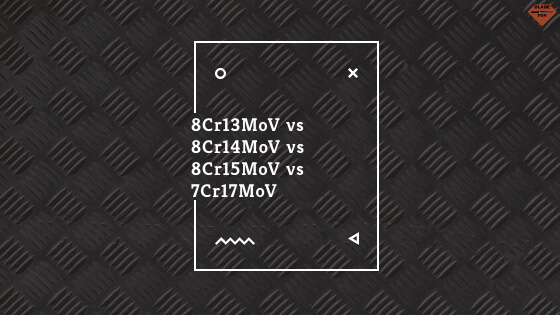There’s quite a few budget steels out there following the general naming pattern of _Cr__MoV. There’s 8Cr13MoV, 8Cr14MoV, 8Cr15MoV, 7Cr17MoV, and more. Now, of course, this all begs the question: What on earth is the difference?
8Cr13MoV, 8Cr14MoV, 8Cr15MoV, and even 7Cr17MoV all have the same elements, but different levels of them. The main difference is corrosion resistance in the 8Cr__MoV. The higher the Cr__ number, the better the corrosion resistance. 7Cr17MoV has better corrosion resistance, but isn’t quite as strong.
That’s the gist of it, but there’s more that goes into it if you want to try to determine which one is better. Let’s check out those differences.
General Composition
They all pretty much have the same general composition, with slight differences in the exact levels.
If we look at 8Cr13MoV, the 8 refers to the percentage of carbon (0.8%), the Cr13 refers to the percentage of chromium (about 13%), the Mo refers to molybdenum, and the V refers to vanadium.
All those components each do different things: The carbon increases strength (it’s important to note that at high levels, carbon leads to brittleness, which means easy chipping and breaking), the chromium increases corrosion resistance, the molybdenum increases hardenability (which basically means that it’s easier to harden, and thus manufacture), and vanadium improves wear resistance and strength.
With the levels of all the elements in them, they’re generally not going to be super hard steels that hold a great edge (but they will be easy to sharpen). They’re budget steels that you shouldn’t feel bad about beating up.
They all have varying levels of the elements they’re composed of, but you’re generally going to see a trend simply by looking at the name. Let’s check out those trends.
| Steel Type: | % of Carbon: | % of Chromium: |
| 8Cr13MoV | 0.8% | 13% |
| 8Cr14MoV | 0.8% | 14% |
| 8Cr15MoV | 0.8% | 15% |
| 7Cr17MoV | 0.7% | 17% |
What all that means:
| Steel Type: | Relative Strength: | Relative Corrosion Resistance: |
| 8Cr13MoV | Roughly the same as 8Cr14MoV and 8Cr15MoV, but stronger than 7Cr17MoV. | Less corrosion resistant than 8Cr14MoV, 8Cr15MoV, and 7Cr17MoV. |
| 8Cr14MoV | Roughly the same as 8Cr13MoV and 8Cr15MoV, but stronger than 7Cr17MoV. | More corrosion resistant than 8Cr13MoV, but less corrosion resistant than 8Cr15MoV and 7Cr17MoV. |
| 8Cr15MoV | Roughly the same as 8Cr13MoV and 8Cr14MoV, but stronger than 7Cr17MoV. | More corrosion resistant than 8Cr13MoV and 8Cr14MoV, but less corrosion resistant than 7Cr17MoV. |
| 7Cr17MoV | Generally weaker than 8Cr13MoV, 8Cr14MoV, and 8Cr15MoV. | More corrosion resistant than 8Cr13MoV, 8Cr14MoV, and 8Cr15MoV. |
It’s important to know that the info from the graphs are all generalities. They’ll all vary depending on where the steel is made and who makes it, how it’s heat treated, how it’s maintained, the edge geometry, and more. Generally, though, that’s what you can expect to see in terms of differences between the steels.
Now, let’s go a bit more in-depth with each steel.
8Cr13MoV
8Cr13MoV, as stated earlier, has about 0.8% carbon in the steel and 13% chromium. This means that, compared to something like 7Cr17MoV, it’s going to be a little bit tougher and hold a better edge, but it won’t have as good corrosion resistance.
8Cr13MoV is generally an all-around good budget steel. It won’t have crazy performance like some higher-end steels, but it will do you just fine for the price point you’ll generally find them at, which is about $35 or less. And since it’s so cheap, you shouldn’t feel bad about beating these knives up.
8Cr13MoV was used quite a bit by some knife companies like Kershaw, but a lot of times now, you’ll see 8Cr14MoV in place of it. Speaking of which…
8Cr14MoV
8Cr14MoV, as stated earlier, has about 0.8% carbon and 14% chromium in the steel. This means that it’s going to be stronger than something like 7Cr17MoV but less corrosion resistant, and about as strong as something like 8Cr13MoV but more corrosion resistant.
This is probably the most common of all the steels you’ll see in this article. A lot of knife companies like Kershaw tend to use this knife steel for their budget knives (which, I must admit, are pretty good knives for the price).
Arguably my favorite knife with 8Cr14MoV steel is the Kershaw CQC-11K. It’s got the Emerson Wave, which is a little hook on the blade that catches on your pants pocket when you pull it out of your pocket, basically causing the knife to open as you pull it out of your pocket. It’s pretty cool. If you’re looking for cool, budget-friendly knife, check out the Kershaw CQC-11K.
8Cr15MoV
8Cr15MoV has about 0.8% carbon and 15% chromium. By now, you should be able to see the trend in how this works. The higher the chromium, the more corrosion resistant. The lower the chromium, the less corrosion resistant. The higher the carbon, the tougher the steel. The lower the carbon, the weaker the steel.
8Cr15MoV is probably the highest quality steel in this article. It balances strength and corrosion resistance. It doesn’t have the corrosion resistance of something like 7Cr17MoV, but it does have more strength than it.
Again, though, that can all vary depending on a bunch of factors like heat treat, maintenance, and edge geometry. But with all of these knife steels, you probably won’t notice much of a difference. They’re all pretty solid budget steels. If you find a budget-friendly knife with them, don’t be afraid of it (especially if it’s from Kershaw, they do really well with these budget steels!).
7Cr17MoV
7Cr17MoV, as you can probably guess, has 0.7% carbon and 17% chromium. It’s the weakest in terms of toughness and edge retention, but the best in terms of corrosion resistance. With all of these, though, you probably won’t notice enough of a difference in order for it to matter.
Basically, they’re all budget friendly steels. Don’t fret too much over which one is better: You probably won’t notice enough of a difference between them all for it to matter.
If you happen to run into a scenario where you find, say, four knives that you like and each one has a different steel type from this article, don’t fret too much over the steel. They’re all budget steels. Just pick the one you like the most and enjoy your new knife.

